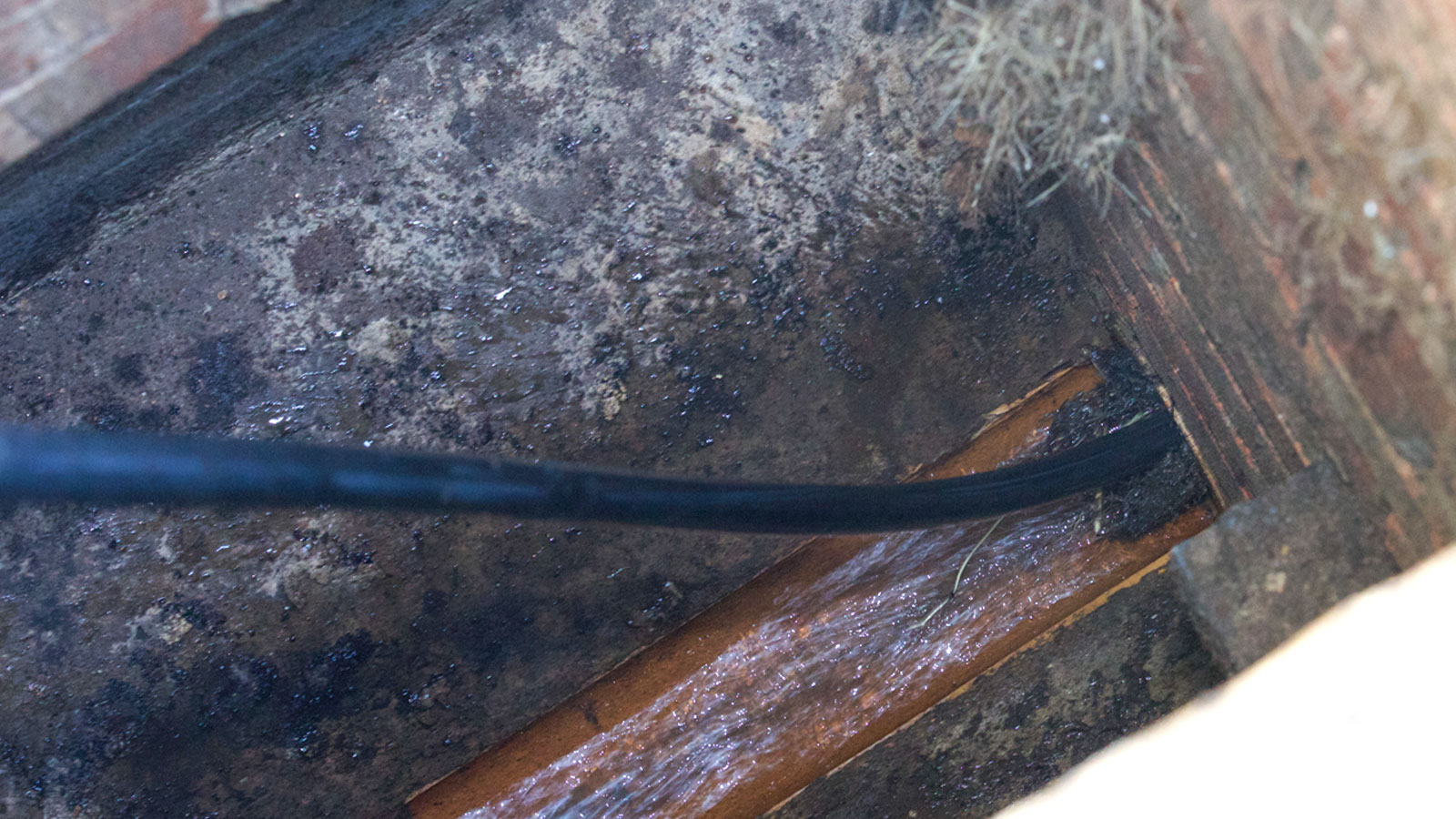How to unblock drains outside: Tips and techniques to keep them working
We reveal what you can do to unblock drains outside, the common causes and when it's time to call in a professional

Knowing how to unblock drains outside can stop those unpleasant smells wafting in from outdoors and make sure that your waste is carried away to the water mains. Drains are there to serve a purpose and to keep it that way they can need a little maintenance and looking after.
If you’re moving into a new home it's a good idea to get a drainage survey done to check all is well. But even if your drains are in good condition they can still get clogged up, especially if you are putting too much toilet roll, wipes and other items that don’t break down into the pipes.
But even if you are careful with what goes into your drains, age and nature can still join in and create unwanted blockages. Here we tell you what you need to know to get rid of any blockages.
How to unblock drains outside: 5 common causes
Drains get blocked for different reasons, some are easier than others to identify and rectify. But if you are having problems with your outside drains it's likely one of the following reasons will be the cause.
1. Blocked drain grid
Check the pipework on the outside of your home and you will see pipes from your bathroom and kitchen typically direct to an outside drain that has a small drain grid cover like this QUERGO Square Drain Cover from Amazon.
This is to stop leaves and larger objects getting into the pipework below ground. Over time leaves, dirt, debris and washing machine dregs can accumulate making the drain cover ineffective, causing any water to flow into the ground around the drain.
2. Food waste, fat and oil
Food waste and oil and fat from cooking can travel to outside drains and accumulate to create hard balls of waste. As oil and fat cools it will congeal and mix with food waste to become hard and this often happens in outside drains.
3. Collapsed drain
The older the pipework in drains the more susceptible it is to collapse. When a drain pipe cracks, or breaks, the weight of the soil can cause the drain pipework to collapse. The soil will then seep into the pipework causing a blockage
Bring your dream home to life with expert advice, how to guides and design inspiration. Sign up for our newsletter and get two free tickets to a Homebuilding & Renovating Show near you.
4. Tree root damage
Tree roots may not have been anywhere near drains when the pipework was originally laid. However, as a tree grows its roots spread and can come into contact with pipework. The roots can force its way into cracks and joints, attracting waste, which can build up and cause a blockage.
5. Toilet roll overload
Toilet paper is designed to dissolve in water, but if you use too much toilet roll on a regular basis it can take longer to break down. The more this happens the more likely clumps of toilet paper are to form. This can then cause a build up eventually leading to a blockage.
Can I unblock a drain myself?
“Yes, you can probably unblock an outside drain on your own” explains Mark McShane Plumbing, Heating, Electrical & Renewables Expert at Boiler Cover UK. “You must identify where the blockage lies and use a plunger, drain rod, or a plumber’s snake to dislodge the debris.” He recommends that, “You should wear protective gloves and eyewear at all times.”
If the problem is something simple like the drain grid is covered with leaves and debris then you can remove, clean and replace. If food waste and fat or toilet rolls are an issue, you should be able to remove them with a drain auger or drain rods. To help stop the problem make sure to dispose of food waste and oil properly and use less toilet roll and always flush.
However, if the problem is more serious and you don't have the tools or simply don’t want to tackle the bigger issues you should call in a professional to sort the problem.
Steps to unblock an outside drain
Before you tackle a drain blockage you will need to invest in a few tools to get the job done. Long rubber gloves, a drain snake, or drain rods like this Faithfull FAIDRSET12 Drain Rod Set from Amazon and protective gear are the essentials.
1. Gear up and get the cover off
First get your protective gear on and lift off the drain cover and put it to one side. You might need a specialist tool or a crowbar to lift before picking up. If the drain cover hasn’t been removed for years you might need a screwdriver to remove debris from around the edges.
2. Assess where the blockage lies
If you can see the blockage, then you can remove it by hand (with gloves might be sensible). If the drain is full of water this typically means that the blockage comes after the chamber - so away from the house. If the drain chamber doesn’t have any water in it and you can’t visibly see the blockage this typically means the blockage is before the chamber - towards the house.
3. Tool up and unblock the blockage
Now fit your drain rods together and push into the pipework until you reach the blockage. Turn the rods clockwise until you feel the rods break through the blockage. Now push the rods back and forth to help break it up. Finally get a hose pipe and run clean water through the pipework to help flush out the debris.
FAQs
Can I use baking soda and vinegar to unblock drains?
Yes you can. Using baking soda and vinegar is an often used combination to unblock drains. But it's typically for smaller blockages as McShane explains, “If it is a minor blockage, then this eco-friendly method should work just fine; a severe clog may require mechanical removal or calling a plumber’s emergency number."
But how do you use it? McShane explains the process, “Standing over your outdoor drain, pour a pot of boiling water down the drain, followed by a half-cup of baking soda. Wait several minutes and then pour in a mixture of one cup of vinegar and one cup of hot water. Be sure to situate a lid or plate over your drain to avoid splashes; you want the reaction happening under the surface of water.”
How much does it cost to unblock an outside drain?
This will depend on whether you decide to tackle the job yourself or call in a professional. But there are other factors as McShane reveals, “Prices to remove a blockage from outside the home can vary wildly from area to area, based on the extent of the blockage, the prerequisite method to remove it, and your location.”
If you are tackling the job yourself you only need to pay for tools and equipment. But the outlay may not be justified if costs exceed what you would pay for a professional. McShane states, “If professional plumbing services are needed, you can expect to pay between £100-£400 or more”. What can you expect for the money? “Services may include camera inspections, hydro jetting or mechanical removal of roots and other deposits. But it's advisable to get quotes from several providers to ensure you're getting a fair price for the service needed.”
Need to know more about drains? Check out our What is drain snake? guide to see how they work and what they can be used for. Along with our Drainage cost guide to see how much new drains might cost you and Building Regulations Part H: Our expert guide to drainage installations to get some invaluable expert advice.
Steve Jenkins is a freelance content creator with over two decades of experience working in digital and print and was previously the DIY content editor for Homebuilding & Renovating.
He is a keen DIYer with over 20 years of experience in transforming and renovating the many homes he has lived in. He specialises in painting and decorating, but has a wide range of skills gleaned from working in the building trade for around 10 years and spending time at night school learning how to plaster and plumb.
He has fitted kitchens, tiled bathrooms and kitchens, laid many floors, built partition walls, plastered walls, plumbed in bathrooms, worked on loft conversions and much more. And when he's not sure how to tackle a DIY project he has a wide network of friends – including plumbers, gas engineers, tilers, carpenters, painters and decorators, electricians and builders – in the trade to call upon.

